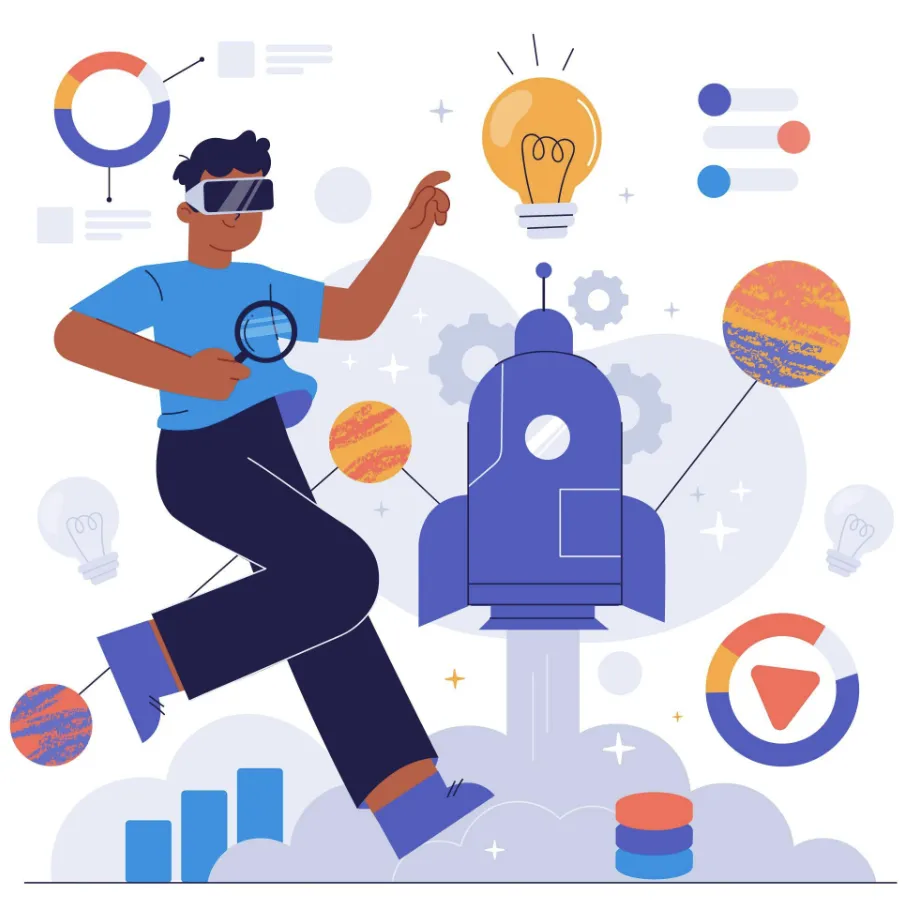What Is Answer Engine Optimization? Complete AEO Guide 2025
Learn AEO strategies to optimize content for AI engines like ChatGPT, Perplexity & voice search. Boost visibility now.
Digital marketing has changed. Being visible isn't just about Google rankings anymore. With AI answer engines like ChatGPT and Perplexity changing how people search, your content needs to be optimized for direct answers.
Answer Engine Optimization (AEO) helps your brand become the chosen answer across AI systems and voice assistants. This guide shows you practical strategies to implement AEO and boost your online visibility.
Table of Contents
- What is Answer Engine Optimization (AEO)?
- AEO vs Traditional SEO
- AEO and Voice Search
- Why Use AEO Strategy
- How to Implement AEO
- AEO Success Metrics
- Content Optimization Strategies
- Technical AEO Requirements
- Frequently Asked Questions
- Conclusion
What is Answer Engine Optimization (AEO)?
Answer Engine Optimization is optimizing content to be selected as direct answers by AI systems. Instead of competing for clicks, you're competing to be the answer.
AEO targets platforms like ChatGPT, Perplexity, Google's AI overviews, and voice assistants. Your content needs to be clear, authoritative, and structured for machine understanding.
Unlike traditional search with multiple results, answer engines provide single, definitive responses. Your content must be relevant and trustworthy enough to be chosen as the source of truth.
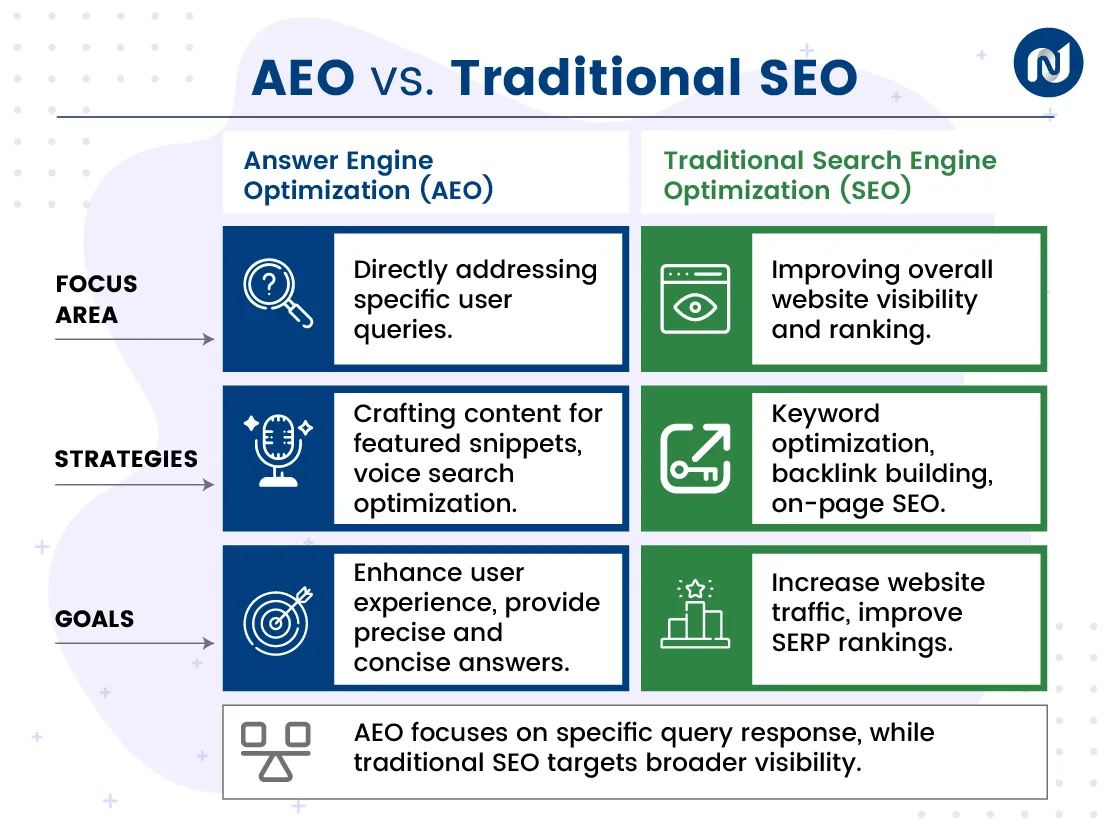
AEO vs Traditional SEO
The key differences between AEO and SEO approaches:
| Aspect | Traditional SEO | Answer Engine Optimization |
|---|---|---|
| Goal | High rankings & traffic | Being the chosen answer |
| Focus | Keywords & backlinks | Direct question answering |
| Platforms | Mainly Google | AI systems & voice assistants |
| Content Style | Keyword optimization | Conversational & structured |
SEO remains important for traffic and rankings. AEO ensures your brand stays visible across AI-powered search platforms where users increasingly find answers.
Both strategies work together. Understanding AI tools helps you create content that performs well in both traditional and AI-powered search environments.
AEO and Voice Search
Voice search is mainstream now. According to Google, 27% of the global online population uses voice search on mobile devices daily.
When someone asks "What's the best marketing strategy?" or "How do I optimize content?", AI systems need reliable sources for direct answers. This is where AEO becomes crucial.
Voice-optimized content characteristics:
- Direct and conversational language
- Natural speech patterns
- Short, scannable answers
- Questions as headings
- Structured data markup
Voice search connects directly with AEO principles. Understanding how language models work helps you create more effective voice-optimized content.
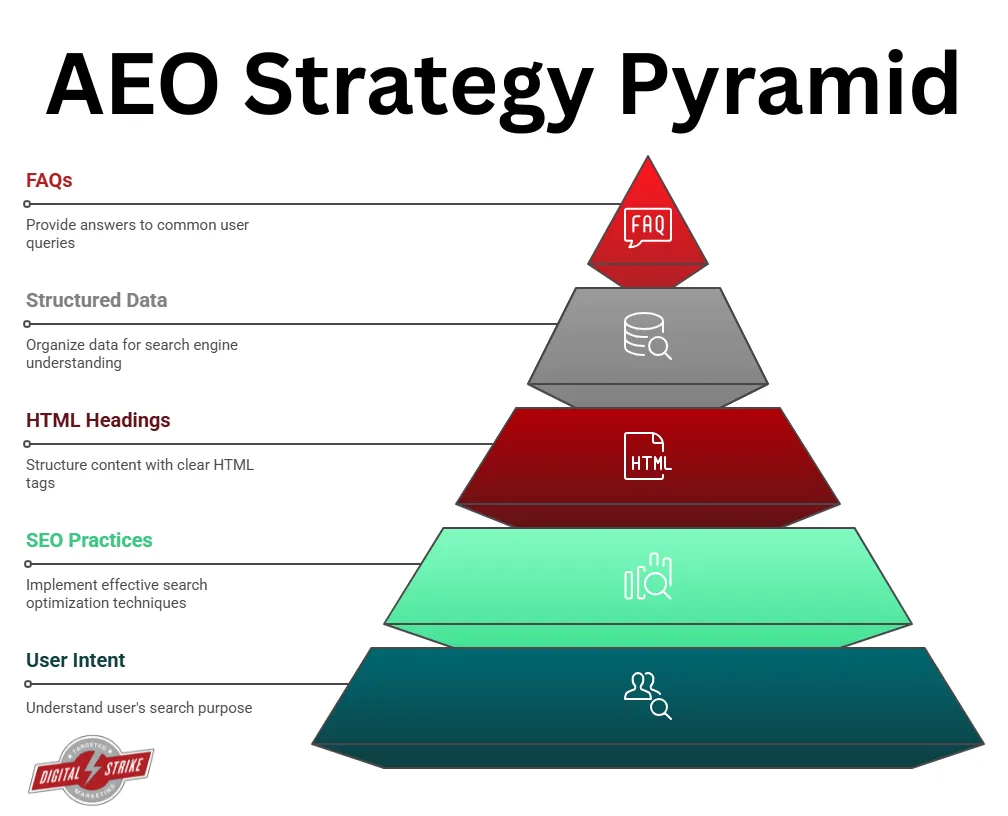
Why Use AEO Strategy
Your customers ask questions across multiple platforms, but most brands only answer in one place. Here's the current search landscape:
| Platform | Daily Searches | Search Type |
|---|---|---|
| 13.7 billion | Traditional & AI overviews | |
| 6.5 billion | Visual & social search | |
| Baidu | 5 billion | Traditional search |
| ChatGPT | 1+ billion | AI-powered answers |
Search behaviors are fragmented. Users discover information through social feeds, marketplaces, AI assistants, and traditional search. Companies focusing only on Google miss opportunities where their audience actively seeks information.
This creates a competitive advantage for brands that position themselves across multiple answer channels.
How to Implement AEO
Create Quality, Informative Content
Content that answers well solves problems quickly with authority and clarity. Focus on understanding user intent, not just inserting keywords.
Build comprehensive resources addressing user questions thoroughly. Effective prompting strategies can help you develop better content approaches.
Identify Your Audience's Questions
Map complete questions, not just keywords. Use tools like AnswerThePublic or Ubersuggest to discover question-based queries your audience asks.
Think about pre-purchase questions, comparisons, and decision-making concerns your customers have.
Build Comprehensive FAQ Sections
FAQ sections provide structured, scannable content that AI systems can easily parse and reuse in summaries and snippets.
Benefits of well-crafted FAQs:
- Address user concerns directly
- Provide AI-parseable structured content
- Improve user experience
- Create featured snippet opportunities
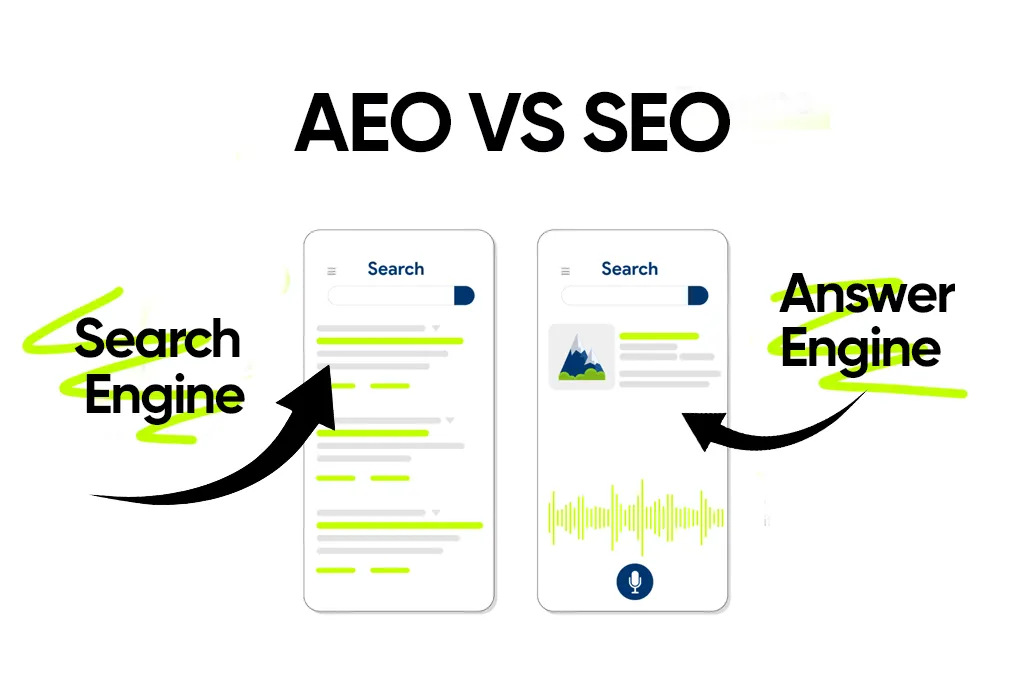
AEO Success Metrics
Traditional Google rankings and organic traffic only show part of the picture. AEO requires new metrics to prove results and guide decisions.
Key metrics to track:
Snippet and Answer Panel Performance
- Click-through rates in featured snippets
- Impressions in AI overviews
- Voice search result appearances
Question-Based Traffic Analysis
- Sessions starting from question queries
- Engagement on informational content
- Time spent on answer-focused pages
Conversion Attribution
- Conversions assisted by AEO content
- Journey-based attribution models
- Lead generation from informational content
| Metric Type | What to Measure | Why It Matters |
|---|---|---|
| Visibility | Snippet appearances | Shows answer authority |
| Engagement | Question-based sessions | Indicates content relevance |
| Conversion | Assisted conversions | Proves business impact |
Content Optimization Strategies
Use Conversational Language
Write how people actually speak and ask questions. Avoid overly technical jargon unless your audience requires it.
Structure Content for Scanning
- Use clear headings and subheadings
- Create bulleted lists for key points
- Include tables for comparisons
- Add summary sections
Build Content Authority
- Include credible sources and citations
- Add author information and credentials
- Update content regularly with fresh data
- Link to authoritative external sources
Understanding prompt engineering principles can help you create more effective content that AI systems prefer to cite.
Technical AEO Requirements
Implement Structured Data Markup
Use schema markup to help search engines understand your content structure. Key schema types for AEO:
- FAQ schema for question sections
- Article schema for blog posts
- Organization schema for credibility
Use Semantic HTML Elements
Proper HTML5 semantic elements help AI systems understand content hierarchy:
<article>for main content<section>for content sections<h1>-<h6>for proper heading structure<time>for dates and timestamps
Optimize Page Speed and Mobile Experience
AI systems favor fast-loading, mobile-friendly content. Ensure your pages load quickly and work well on all devices.
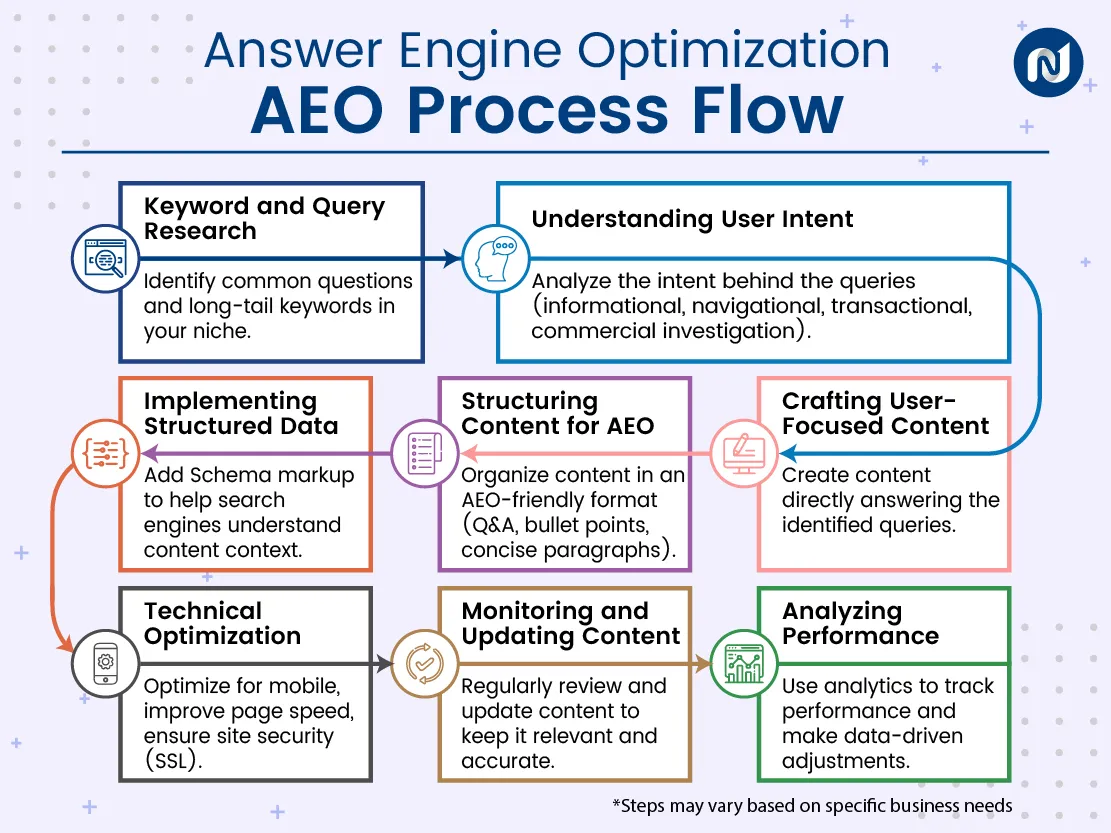
Frequently Asked Questions
What is Answer Engine Optimization (AEO)?
AEO is optimizing content to be selected as direct answers by AI systems like ChatGPT, Perplexity, and voice assistants, focusing on being the authoritative source rather than just ranking well.
How does AEO differ from traditional SEO?
While SEO focuses on rankings and traffic, AEO optimizes content to be chosen as direct answers by AI systems and voice assistants across multiple platforms.
Why is AEO important for businesses?
With 27% of users using voice search and AI answer engines gaining popularity, AEO helps brands maintain visibility across multiple search touchpoints beyond just Google.
What are the key AEO strategies?
Focus on creating FAQ sections, using conversational language, implementing structured data, optimizing for voice search, and building content authority.
How do I measure AEO success?
Track metrics like snippet CTR, question-based session starts, engagement on informational content, and conversions assisted by AEO-friendly content.
Conclusion
AEO represents the evolution of SEO from a traffic strategy to an influence strategy. Marketing leaders who recognize this shift gain a clear competitive advantage.
The future belongs to brands that understand how to create content serving both human users and AI systems. Success requires optimizing for questions, answers, and decisions across all platforms where your audience seeks information.
Start implementing AEO strategies today. Focus on creating authoritative, well-structured content that answers real user questions. The brands that adapt now will dominate visibility in the AI-powered search landscape of tomorrow.

